Private First Class Lester Ernest Whitesel
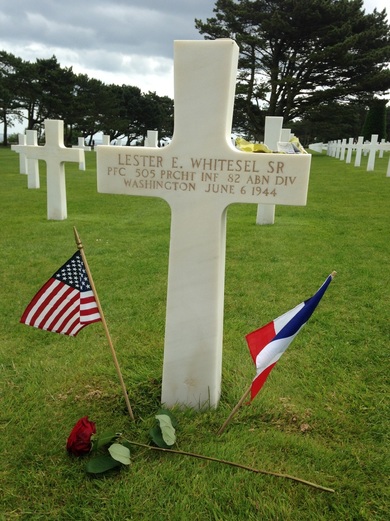
- Unit: 82nd Airborne Division, 505th Parachute Infantry Regiment, 3rd Battalion, Company G
- Service Number: 39171426
- Date of Birth: August 19, 1913
- Entered the Military: March 22, 1942
- Date of Death: June 6, 1944
- Hometown: Hoquiam, Grays Harbor
- Place of Death: Sainte-Mère-Église, France
- Award(s): Purple Heart
- Cemetery: Plot F, Row 12, Grave 42. Normandy American Cemetery, Colleville-sur-Mer, France
Mentored by Ms. Irene Soohoo
Prairie High School and Pleasant Valley Middle School
2015-2016
Early Life
Private First Class Lester Ernest Whitesel was born on August 17, 1913, to Louis H. Whitesel and Lillian Hank. In the 1920 federal census, six-year-old Lester Whitesel was classified as a “roomer” along with his four-and-a-half year old brother Delbert Whitesel in Hoquiam, Grays Harbor, Washington. Lester and Delbert lived with Nelson A. Gary, Nettie Gary, Iva E. Gary, and Carl W. Gary. It is unclear why the two brothers lived without their parents, but frequent moves were part of their childhood. Sadly, Whitesel experienced the tragic loss of his brother in 1926.
Grays Harbor County 1930 census revealed Whitesel lived with his Uncle Christian, who was a 40-year-old sawyer at a plywood plant, Aunt Mary, Uncle Edward, and cousins, Ethel (age 21), who worked as a paper sorter at a mill, and Ralph Whitesel (age 19), who was unemployed. During this time, Whitesel drove a truck for the Double A Meat Market in Hoquiam.
Everyone in the Whitesel family pitched in to help pay bills and put food on the table. By 1934, records showed that Whitesel reunited with his father in 1934 and they lived together at the A-1 Meat Market; the same business Lester worked for as a driver. In 1942, Whitesel earned a promotion to meat cutter.
Whitesel married Grace Lenora Paradis in 1937, in Hoquiam, Grays Harbor, Washington. The couple had one child Lester Ernest “Ernie” Whitesel, Jr., who was born in June 1937.
The Whitesels raised their son together until 1942. Ernie was four when Whitesel left for the war. At some point during Lester’s training, Grace moved to the Sidall Hotel in Astoria, Oregon, leaving Ernie at an orphanage in nearby Aberdeen.
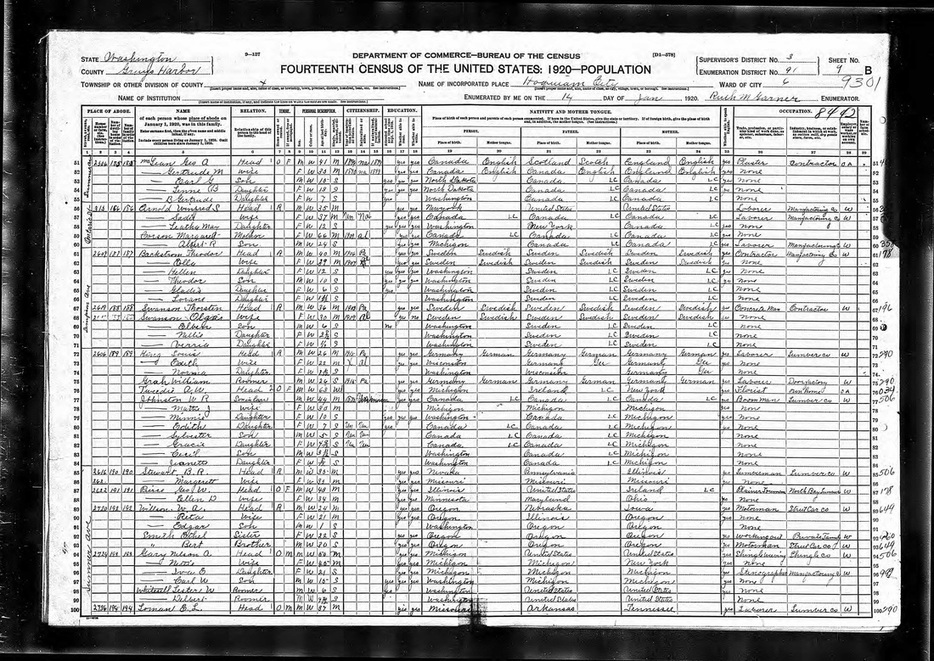


Homefront
Grays Harbor earned recognition for the logging and wood industry as well as its mill production. These industries employed a number of the local residents, but the Great Depression affected the local economy deeply. Mills and logging companies closed, leaving thousands hungry and homeless.
The Grays Harbor community witnessed unemployment marches and strikes. Riots broke out in the 1930s, causing more tensions. Thousands marched to the capitol, Olympia, and waited until the police came to arrest those who would not move.
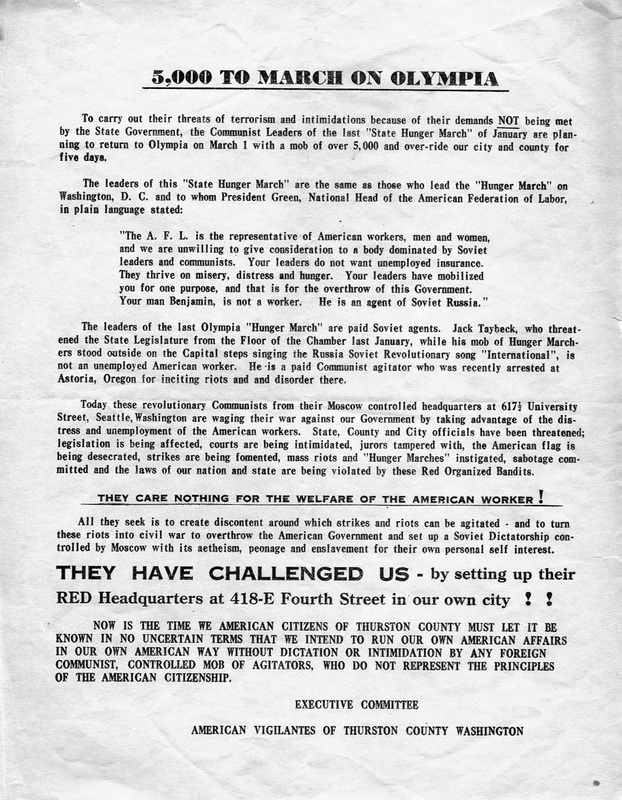
Military Experience
Whitesel enlisted at the Tacoma Induction Center March 22, 1942, and trained as a paratrooper in the 505th Parachute Infantry Regiment of the 82nd Airborne Division. His records showed he had blue eyes, had several teeth missing, measured 70 inches tall, and weighed 140 pounds. He began his training at Fort Ord and Camp St. Louis Obispo in California and continued to train at Fort Benning, Georgia, and Fort Meade, Maryland. His unit moved to Great Britain to prepare for the Normandy Invasion.
On June 6, 1944, Whitesel’s day started when the 505th Parachute Infantry Regiment boarded their planes just after midnight and flew across the English Channel. The 82nd Airborne Division’s mission was to protect the right flank of the Cotentin peninsula by destroying the Douve River bridges and capturing bridges on the Merderet River. They also had to capture Sainte-Mère-Église, a Norman town occupied by a German anti-aircraft garrison. This goal was to secure pathways inland for U.S. forces landing at Utah Beach later that morning.
The 82nd Airborne Division paratroopers jumped off the planes from 1:21 am to 2:44 a.m. over the Merderet River while the 101st Airborne Division paratroper’s target was land west of Sainte-Mère-Église. Due to weather conditions, both divisions missed their marks, leaving men scattered across the Cotentin Peninsula.
Unfortunately for those dropped accidentally right over Sainte-Mère-Église, a house fire near the town square and church lit up the sky. German troops on the ground began to fire. Although the 505th Parachute Infantry Regiment had the most accurate drop among the Airborne Divisions, some paratrooper companies completely missed their designated drop zones and landed in surrounding fields deliberately flooded by the Germans. Many paratroopers had a difficult time finding their units if they survived getting shot out of the sky, snagged on trees, or drowned in water six-feet-deep loaded down with 70 to 80 pounds of gear. We do not know how or exactly where Private First Class Whitesel died. Company G dropped over Sainte-Mère-Église.
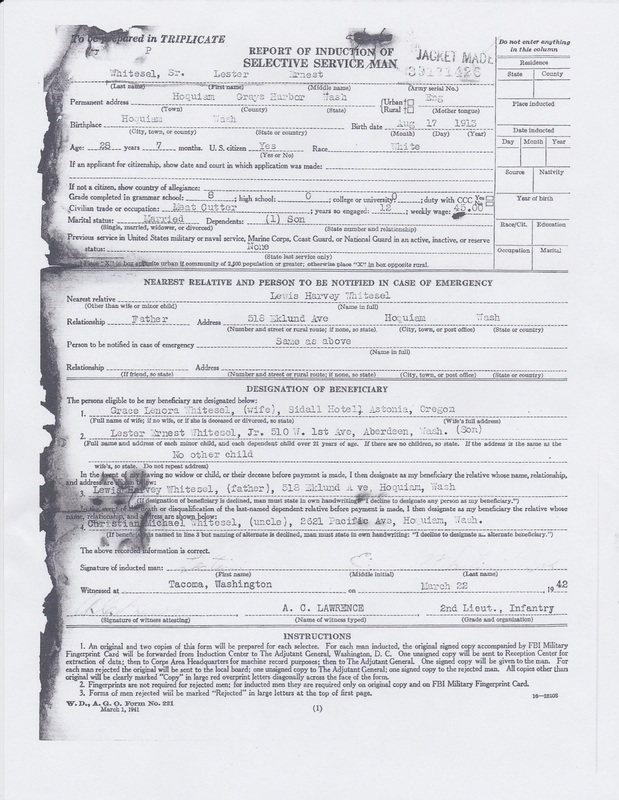


Eulogy
Dear Private First Class Lester Ernest Whitesel,
From the very beginning your life was filled with confusion and dysfunction. But over time you worked to build a life for yourself, for your wife, and for your new son, Ernie. Sadly, that life was cut short.
In March 1942, you enlisted in the U.S. Army at the Tacoma Induction Center, but you were very different from the others. You were married, about ten years older than most. You left your family to fight in a raging war that affected everyone, but had to leave your only child, Ernie Whitesel who was four years old.
Ernie recalls seeing you before you left and you gave him a cap with bubble gum. He cherished the memento that was unfortunately lost when Ernie left Hoquiam to serve in the military himself.
Your commanding officers, Lieutenant William Eckman and Lieutenant Colonel Benjamin Vandervoort, reported the drops often missed their designated zones and clearly flew too fast and too high resulting in hard landings. Some paratroopers were tangled in trees, shot on sight, and even fell down wells or snagged on church steeples. Exactly how and when you died is unknown, as you were first listed as missing until your remains were found and identified.
The D-Day casualties numbered ten thousand dead, missing, or wounded; less than half of what the planners expected and considered acceptable. You were one of the 2500 American paratrooper casualties. The letters the government sent to your mother and father at the time clearly shows how your commanding officers and peers thought of you. On August 16, 1944, Major General M. B. Ridgway wrote, “Private First Class Whitesel was always surrounded by a group of friends while in Garrison. He was liked and respected by everyone who knew him and his loyalty to friend, unit, and country reflected great credit to himself and the military service.” It seemed you knew how to relate well to others even though you had such a challenging childhood.
I located and contacted your son, Ernie. He lives in Phoenix, Arizona, and was very excited to know someone was researching your life and honoring your sacrifice. He wanted me to say to you: “Dear Dad, as I watched you walk away on that eventful day, I was sure I’d see you soon. I waited for months, only to realize that was not to happen. I had lost my best pal, my hero. I have wondered what your words of encouragement you would have given me, in what direction you would have steered me. I missed the pats on the back and the love in your eyes. I miss not having you help me on my journey in life, to share my successes and failures. I miss all that could have been. With the reading of this eulogy in June I will be 79 years old and have inherited excellent genes, thanks to you. I hope to be blessed to reunite with you in heaven. Your loving son, Lester Ernest Whitesel, Jr.”
You were not just a number, one of ten thousand casualties. You were a person remembered and loved after so many years by your only child. It is my honor to make sure your story will continue to live on, through your son who keeps and cherishes your awards and me. I lit a candle at Ste. Mere Eglise to show that you will always be remembered and will continue to influence my life.
I want you to know that your life mattered; that you made a difference; that you gave your life so that Hitler could be stopped and France freed. I thank you, Silent Hero Private First Class Lester Ernest Whitesel, Sr., and so does your son. Just as W. J. Landry said in his condolence letter to your wife on December 5, 1944, “We profoundly appreciate the greatness of your loss, for in a very real sense, the loss suffered by any of us in this battle for our country, is a loss shared by all of us.”
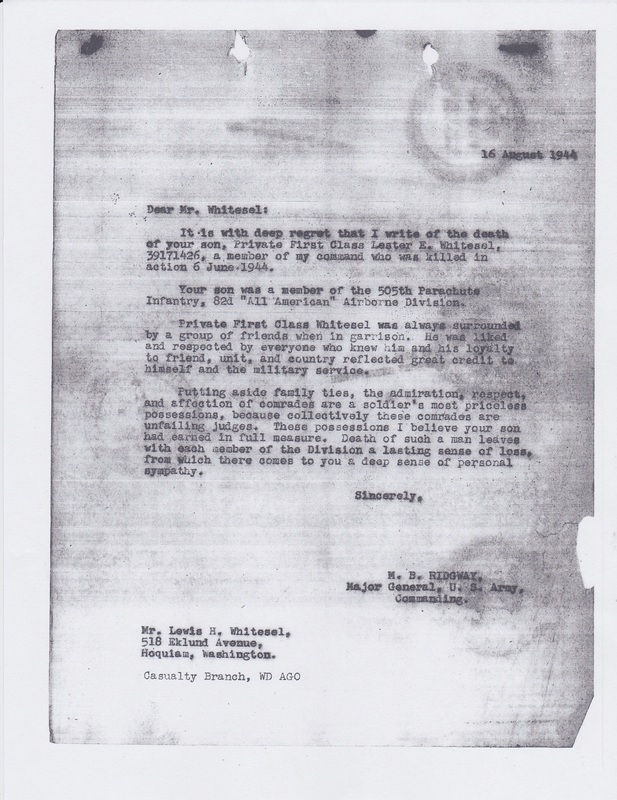
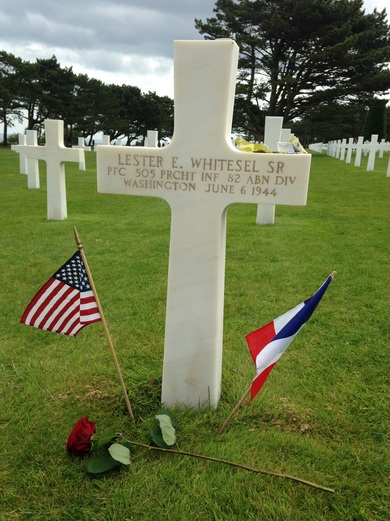
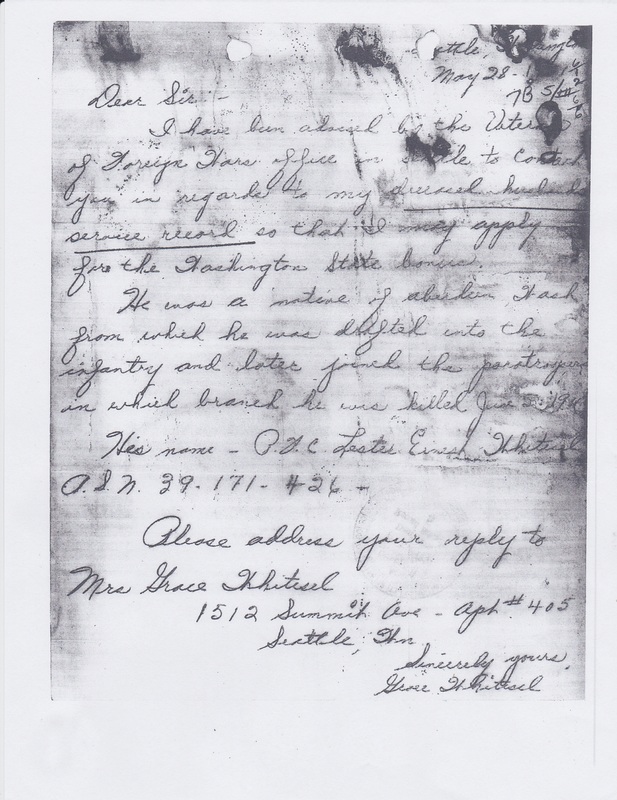
Reflection
The Normandy: Sacrifice for Freedom Student & Teacher Institute taught and is continuing to teach me how important remembering and sharing the lives of those who have passed. Just as all of us have family members who have passed away and are always remembered and talked about, these World War II soldiers deserve the same respect.
Was Grace so heartbroken from his death that she could not bear to answer the desperate letters sent by the military for a family member to acknowledge his death? Why did she leave her small family so soon? All of these questions will never be answered. Did the war have any effect on the outcome? The war split families, destroyed relationships, and brought sadness to towns that had touched everyone. It is all so hard to comprehend and accept that it was so common to lose a father, husband, son, brother, or friend. Nowadays, no one is able to understand the depth and enormity of loss the entire world felt. Millions of people died over the span of the official U.S. involvement in World War II from the Pearl Harbor attack, D-Day, and finally the end on September 2, 1945.
How could so many men die and not receive what they deserved–respect and remembrance? There was so much horror in such a small amount of time, many were lost and forgotten. This project is an effort to bring these Silent Heroes to the attention of the citizens in their state and like a pebble in a pond, create ripples to emanate out and keep the stories alive.
The goal of this program is to understand the sacrifice each soldier made and to share their stories because their generation is nearly gone and the closest ones to them are constantly and quickly slipping away. These stories must be shared, learned from, and enjoyed, so future generations remember and carry their legacy forward.
Bibliography
Primary Sources
505th Parachute Infantry Regiment, World War II Operations Reports, 1940-1948. Record Group 407 (box 10473). National Archives at College Park, College Park, MD.
5,000 to March on Olympia. American Vigilantes of Thurston County, Washington. 1933. Washington State Archives.
“Lester Whitsel.” Headstone and Interment Records for U.S. Military Cemeteries on Foreign Soil, 1942-1949. ancestry.com.
Lester Whitsel, Individual Deceased Personnel File, Department of the Army.
Lester Whitsel, Official Military Personnel File, Department of the Army, RG 319, National Archives and Records Administration – St. Louis.
“Lester Whitsel.” World War II Army Enlistment Records, 1938-1946. ancestry.com.
“Lester Whitsel.” WWII Draft Cards Young Men, 1940-1947. ancestry.com.
Osmont, Marie-Louise. The Normandy Diary of Marie-Louise Osmont 1940-1944. New York: Random House, 1994. Print.
Paratrooper Training. Photograph. June 24, 1941. National Archives and Records Administration (111-SC-120574).
Troops of 501st Parachute Battalion preparing to board plane at Lawson Field, Fort Benning, Ga. Photograph. June 1941. National Archives and Records Administration (111-SC-120240).
Tucker, William H. Parachute Soldier: From the Diary of William H. Tucker, 1942-1945. 1994.
Tucker, William H. Parachute Solder’s Post War Odyssey. Harwichport: International Airborne Books, 1996.
Washington. Greys Harbor County. 1920 U.S. Federal Census. ancestry.com.
Washington. Greys Harbor County. 1930 U.S. Federal Census. ancestry.com.
Whitesel, Jr., Lester Ernest. Telephone Interview. July 21, 2016.
Wurst, Spencer F. and Gayle Wurst. Descending from the Clouds: A Memoir of Combat in the 505 Parachute Infantry Regiment, 82nd Airborne Division. Havertown: Casemate, 2004.
Secondary Sources
Ambrose, Steven E. Band of Brothers: E Company, 506th Regiment, 101st Airborne from Normandy to Hitler’s Eagle’s Nest. New York: Simon and Schuster, 1992.
Beevor, Antony. D-Day: The Battle for Normandy. New York: Penguin, 2009.
Burriss, T. Moffatt. Strike and Hold: A Memoir of the 82nd Airborne in World War II. Dulles, Virginia: Potomac Books, 2000.
D-Day: The Total Story: Vol. 2. History Channel. 1994. DVD.
”History of the 505th PIR and 3rd Brigade.” Accessed July 25, 2016. www.505thpantherassociation.org/history.html.
Keegan, John. Six Armies in Normandy: From D-Day to the Liberation of Paris. London: Random House, 2004.
Kershaw, Alex. The Bedford Boys: One American Town’s Ultimate D-Day Sacrifice. Cambridge, Massachusetts: Da Capo Press, 2003.
“Lester Whitesel.” American Battle Monuments Commission. Accessed May 9, 2020. www.abmc.gov/decedent-search/whitesel%3Dlester.
LoFaro, Guy. The Sword of St. Michael: The 82nd Airborne Division in World War II. Cambridge: Da Capo Books, 2011.
Murphy, Robert M. No Better Place to Die: Ste-Mere-Eglise, June 1944: the Battle for La Fiere. Havertown: Casemate Publishers, 2009.
Nordyke, Phil. Four Stars of Valor: The Combat History of the 505th Parachute Infantry Regiment in World War II. Minneapolis: Zenith Press, 2006.
Weinberg, Gerhard L. World War II: A Very Short Introduction. Oxford: Oxford University Press, 2014.
Wieviorka, Olivier. Normandy: The Landings to the Liberation of Paris. Cambridge: Harvard University Press, 2008.

